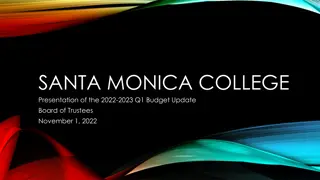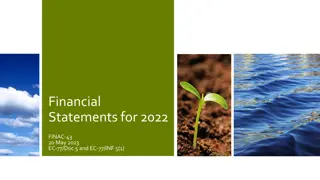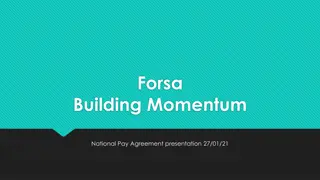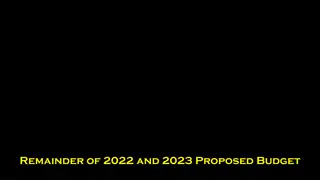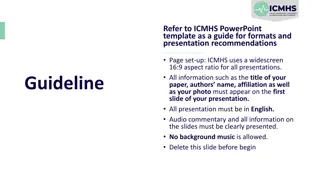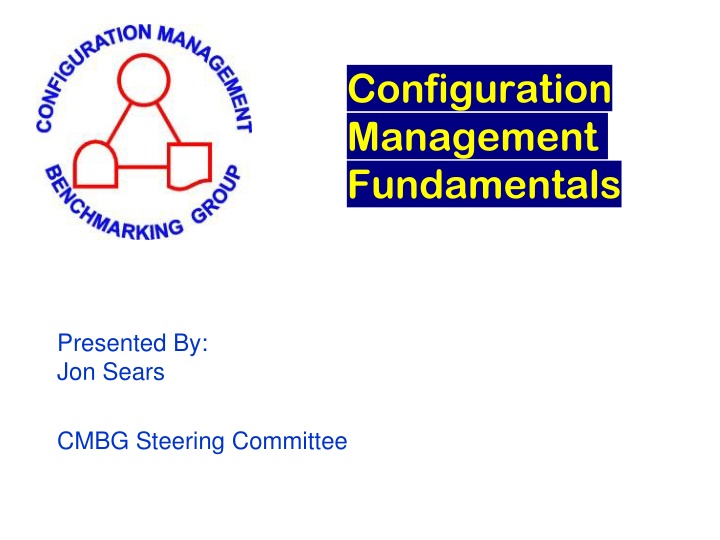
Brief History of Configuration Management in the Nuclear Industry
Explore the evolution of configuration management in the nuclear industry from the mid-60s to the 1980s, including challenges faced by utilities in design maintenance and document upkeep. Discover key events like the Three Mile Island accident and industry initiatives aimed at guidance and consistency.
Download Presentation

Please find below an Image/Link to download the presentation.
The content on the website is provided AS IS for your information and personal use only. It may not be sold, licensed, or shared on other websites without obtaining consent from the author. If you encounter any issues during the download, it is possible that the publisher has removed the file from their server.
You are allowed to download the files provided on this website for personal or commercial use, subject to the condition that they are used lawfully. All files are the property of their respective owners.
The content on the website is provided AS IS for your information and personal use only. It may not be sold, licensed, or shared on other websites without obtaining consent from the author.
E N D
Presentation Transcript
Configuration Management Fundamentals Presented By: Jon Sears CMBG Steering Committee
A Brief History of CM in the Nuclear Industry Configuration Management in military and aerospace industry geared towards product conformance to facilitate interchangeability of parts while still satisfying the overall design requirements MIL-STD-973 (1992), Configuration Management (later replaced by ANSI/EIA-649-1998)
A Brief History of CM in the Nuclear Industry Nuclear plants in mid 60 s to early 80 s typically designed by AEs under contract Final design documents typically turned over to the utility at the end of construction Little knowledge transfer of design info to utility engineering organization Utilities struggled to deal with long term design maintenance and related document upkeep
A Brief History of CM in the Nuclear Industry Early indicators that the nuclear plant design basis knowledge was becoming disconnected from the physical plant IE Bulletin 79-14 uncovered calculation discrepancies undocumented modifications document discrepancies as-built problems
A Brief History of CM in the Nuclear Industry TMI Accident (1979) Three Mile Island accident was a partial core melt down that occurred on March 28, 1979 in one of the two TMI nuclear reactors. Stuck open relief valve Human Factors items and operator training Design indicator deficiencies INPO formed 9 months later.
A Brief History of CM in the Nuclear Industry Salem ATWS event (1983) Generic implications identified in NUREG-1000 and NRC Generic Letter 83-28 compliance with vendor recommendations part and procurement issues vendor manual controls Industry initiatives by INPO, NUMARC and EPRI to provide guidance and consistency
A Brief History of CM in the Nuclear Industry Davis Besse Loss of Feedwater event (1985) Led to NRC Safety System Functional Inspections (SSFIs) and NUREG-1154 difficulties maintaining operational readiness of safety systems lack of understanding design bases Voluntary design basis reconstitution, DBDs and self- evaluation NUREG-1397, NUMARC 90-012, INPO 87-006 and NUREG/CR-5147
A Brief History of CM in the Nuclear Industry Browns Ferry (1985) Browns Ferry fire in Unit 1 (1975) led to changes in NRC standards for Fire Protection All three Browns Ferry units shut down voluntarily in March 1985 due to CM related problems - containment isolation testing (Unit 1), reactor water level instrumentation (Unit 2) Unit 1 restarted in May 2007 after 22 year shutdown Led to creation of Appendix R to 10CFR50
A Brief History of CM in the Nuclear Industry Nuclear Information and Records Management Association (NIRMA) CM Committee developed solution control of technical information by engineering and operations personnel mature records management and document control process PP02-1994 Position Paper on Configuration Management Program NIRMA TG19-1996 Configuration Management of Nuclear Facilities Basis for ANSI/NIRMA CM-1.0-2000
Configuration Management Configuration Management Fundamentals Fundamentals CM Equilibrium CM Equilibrium Equilibrium Upsets Equilibrium Upsets CM Process Model & Equilibrium Restoration CM Process Model & Equilibrium Restoration Using CM to protect Design and Operating Margins Using CM to protect Design and Operating Margins An Individual s CM Responsibilities An Individual s CM Responsibilities Letting CM get out of Control is Costly Letting CM get out of Control is Costly
What is CM? The integrated processes that control the activities of design, construction, procurement, operations, and maintenance to ensure that the configuration of the facility is established, approved and maintained Require- ments Facility Config Info Physical Config The objective of CM is the conformance of the three elements represented by the CM Equilibrium Model
CM Equilibrium Requirements Design Require- ments Technical requirements, derived from the licensing process, or contractual that are reflected in the final design. What Needs to be there Licensing characteristics and parameters, referred to as the Licensing Basis, needed for the facility to perform its function Requirements come from a number of sources; NRC regulations, OSHA, state laws, management direction, design preferences, etc. For New Builds in particular, Owner Requirements specified in a contract
CM Equilibrium Facility Configuration Information Documentation and Data that define how the plant is designed, operated and maintained. Facility Config Info What we say is there Design Output Documents and Data; drawings, specifications, calculations, databases, test plans, etc. Operational Configuration Documents; system alignment checklists, lockout & tagout data, setpoints Other Operating, Maintenance, Training and Procurement Information; corrective & preventive maintenance, calibration procedures, lesson plans, safeguards SSC information, etc.
CM Equilibrium Physical Configuration Actual physical location, arrangement and material condition of Structures, Systems and Components (SSCs) Physical Config What is actually there SSCs as installed (design configuration) Component position (operating configuration) SSC Condition Equipment Reliability SSCs include a component s electrical, chemical, and mechanical properties, liquids & coatings, and computer hardware & software
CM Equilibrium Processes must assure that: Elements conform all the time CM Equilibrium is restored in a timely manner if the elements do not conform All Changes are Evaluated and Approved People are trained and qualified Equilibrium conformance can be verified Require- ments Facility Config Info Physical Config
CM Equilibrium Processes are the administrative and management measures used to ensure the configuration is maintained. These processes include; design control document control work management operability, functionality surveillance & test programs work protection isolation formal training and certification assessments Require- ments Facility Config Info Physical Config
Identifying and Restoring CM Upsets
CM Equilibrium Upsets Require- ments Facility Config Info Physical Config Upsets are discrepancies within any one of the three elements or between any of the elements. The following slides provide further explanations and examples
CM Equilibrium Upsets Upsets within any of the three Elements Require- ments The design basis of an SSC is often described in multiple places in the FSAR and could be in conflict. Facility Config Info Physical Config A drawing and an operating procedure may be in conflict A label on a component my not be updated after the component was changed with a different component type.
CM Equilibrium Upsets Upsets Between Design Requirements & Facility Configuration Information Require- ments Equipment Specifications are less conservative than FSAR Design Basis values Facility Config Info A test requirement in the FSAR is not included in the Plant Test Program Operating procedure conflicts with a setpoint in the Tech Specs A procedure conflicts with OSHA personnel safety requirements.
CM Equilibrium Upsets Examples FSAR assumes a system can be considered operable provided an operator checks the component once per shift. Operations cost-cutting move changed rounds to once per day. A modification is installed that puts in a new design pump, but affected preventive maintenance plans were not updated Management commits to a later code edition and the requirements don t get flowed down to all required documents Require- ments Facility Config Info
CM Equilibrium Upsets Upsets Between Physical Config & Facility Configuration Information The most common CM Equilibrium Upset Drawing to plant discrepancies Midnight Mods The drawing may not be wrong! Maintenance uses out of calibration test equipment that invalidates test Vendor Notice specifying a new lubrication requirement is not implemented in plant An overgrown tree is removed with a bald eagles nest in a protected area. The tree is shown on the site plan with a note not to remove. Facility Config Info Physical Config
CM Equilibrium Upsets Upsets Between Design Requirements & Physical Configuration Design Require- ments Failure of SSC to meet design performance criteria specified in an Inservice Test Procedure Equipment exceeds allowable limits in a Tech Spec Unexpected degradation in SSC performance During a system flush, effluent discharge exceeds EPA Permit Limits Physical Config
CM Equilibrium Upsets Examples Design Require- ments Design calculation assumes that an operator can reach a valve to manually close it in 10 minutes. A seismic upgrade included a new load-bearing wall creating an obstacle to access the valve (i.e., increased time to close the valve). Erosion or corrosion of piping systems exceeds ASME Code limits committed to in the FSAR. Physical Config
CM Equilibrium Restoration CM Equilibrium Restoration The following slides present a high level model using integrated processes to return CM Upsets to Equilibrium The Process starts with a discrepancy found and recorded in the Corrective Action Program or a desire to change the plant to improve performance. The question protocol addresses the 3 CM elements
CM Equilibrium Restoration Evaluate Identified Problem or Desired Change Change Facility Configuration Information ? Change Physical Configuration ? Do Change Requirements ? No No No Nothing More CM Equilibrium Yes Yes Yes Physical Configuration Change Authorization Process Requirements Change Process Facility Configuration Information Change Process CM Equilibrium-The Desired End State SSCs performing as expected People are being trained Procedures are in place and being followed CM Program is being monitored/trended
CM Equilibrium Restoration Evaluate Identified Problem or Desired Change Change Facility Configuration Information ? Change Physical Configuration ? Do Change Requirements ? No No No Nothing More CM Equilibrium Yes Yes Yes Physical Configuration Change Authorization Process Requirements Change Process Facility Configuration Information Change Process Evaluate Identified Problem or Desired Change Apparent discrepancy (discovered error) Unsatisfactory test results Desired change (modification, Equivalency Evaluation, manipulating SSCs)
CM Equilibrium Restoration Implementing Documents Evaluate Identified Problem or Desired Change Problem Identified through Self Assessment Program, System Health Monitoring Program, Periodic Test and Surveillance programs, etc. Problem Evaluated in Corrective Action Program, Engineering Change Request, Work Request, etc.
CM Equilibrium Restoration Evaluate Identified Problem or Desired Change Change Facility Configuration Information ? Change Physical Configuration ? Do Change Requirements ? No No No Nothing More CM Equilibrium Yes Yes Yes Physical Configuration Change Authorization Process Requirements Change Process Facility Configuration Information Change Process Change Requirements? Is a Licensing Requirements impacted? Do I want to accept the condition and change the Requirement? Does a change affect an Owner (contract) Requirement? Do I want to negotiate a change to the Contract?
CM Equilibrium Restoration Implementing Documents Requirements Change Process Evaluate impact on Requirements Processes to evaluate impact of a Requirement include Operability (do I have to enter a Limited Condition of Operation until requirement discrepancy is resolved?), 10CFR50.59 Process (do I have to notify the NRC if I change the requirement), FSAR Revision or License Amendment Procedure (the process to change the requirement in the Licensing Basis). For Contracts, enter contract change process
CM Equilibrium Restoration Evaluate Identified Problem or Desired Change Change Facility Configuration Information ? Change Physical Configuration ? Do Change Requirements ? No No No Nothing More CM Equilibrium Yes Yes Yes Physical Configuration Change Authorization Process Requirements Change Process Facility Configuration Information Change Process Change Physical Configuration? Modify SSCs or change position of components? Use Work Control Process to repair a degraded SSC. Use Engineering Change Process to change Configuration
CM Equilibrium Restoration Implementing Documents Physical Configuration Change Authorization Process Physical Configuration Change Authorization Process Design Change Procedure, Equivalency Change Procedure, Temp Mods Procedure, Work Control Procedure, Conduct of Operations Procedure, etc.
CM Equilibrium Restoration Evaluate Identified Problem or Desired Change Change Facility Configuration Information ? Change Physical Configuration ? Do Change Requirements ? No No No Nothing More CM Equilibrium Yes Yes Yes Physical Configuration Change Authorization Process Requirements Change Process Facility Configuration Information Change Process Change Facility Configuration Information? Design Output documents (drawings, calcs, specs, etc.) Operational configuration documents Other operating, maintenance, training, etc. documents The job is not complete until the paperwork is done
CM Equilibrium Restoration Implementing Documents Facility Configuration Information Change Process Facility Configuration Information Change Process Drawing update procedure, procedure update procedure, database update procedure, SAR update procedure, maintenance procedure on documenting work package completion, etc. NOTE: Changing a document only may still require an Engineering Change if the design requirements of an SSC are changed. 33
CM Equilibrium Restoration Evaluate Identified Problem or Desired Change Change Facility Configuration Information ? Change Physical Configuration ? Do Change Requirements ? No No No Nothing More CM Equilibrium Yes Yes Yes Physical Configuration Change Authorization Process Requirements Change Process Facility Configuration Information Change Process Do Nothing More Finally a decision may be made to Use As Is Document your conclusion in an appropriate document !
Using CM to Protect Design and Operating Margins Margin is simply additional capability added to an SSC to prevent failure due to wear and tear, or adding additional load. The additional capability is broken into: Analytical Margin The margin that is required to meet your licensing basis imposed by codes and standards Design Margin - Additional conservatism added during EPC for unanticipated conditions or later adding new loads. Operating Margin - The band of normal events and events of moderate frequency
CM Equilibrium Margins Protect the Design Basis Design Basis Design Configuration conforms to Design Basis Design Configuration Operational Configuration conforms to Design Configuration Operational Configuration Each boundary has margins to protect these limits
Margins Failure Point Undetermined depends on many variables Current Licensing Basis in Design Documents and FSAR Ultimate Capability Analytical Margin controlled by License Analyzed Design Limit Design Margin controlled by Engineering Operating Limit controlled by Operations Operating Margin Documented on design documents Range of Normal Operation Notes on Model describes one parameter only; different parameters may be interrelated doesn t represent all possible limits and setpoints gaps not intended to represent relative size of margins may be zero
Margins Other Limits and Setpoints SSC Operability is Challenged Ultimate Capability Analytical Margin controlled by License Analyzed Design Limit Design Margin controlled by Engineering Operating Limit Operating Margin controlled by Operations Range of Normal Operation Operator Alarm (HI-HI) Tech Spec Limits Operator Alarm (HI)
An Individuals CM Responsibilities Performing routine activities in a manner to achieve CM Program objectives and principles. Ensure conformance of the licensing basis requirements with plant information and the physical plant. Ensuring that changes made to configuration documents are reflected in other affected documents. Identifying configuration discrepancies through established corrective action processes. Providing missing information found/developed during research to the appropriate data owner for verification and entry.
E EARLY ARLY I INDICATORS NDICATORS T THAT HAT CM W CM WAS AS N NOT OT B BEING EING A APPLIED PPLIED MILLSTONE NPP SHUTDOWN (EARLY 1996) THE PLANT HAD BEEN ROUTINELY OFF-LOADINGA FULL CORE DURING REFUELING UNFORTUNATELY, THIS WAS NOTIN THEIR LICENSEAND NRC HAD NOT APPROVEDTHE MANEUVER MORE UNFORTUNATELY, A WHISTLEBLOWER HAD BEEN UNSUCCESSFULAT CONVINCING UTILITY MANAGEMENT ANDTHE NRC THAT THERE WASAN ISSUE UNTIL HE TOOK HIS STORYTO TIME MAGAZINE FACING EXTREME POLITICALAND PUBLIC PRESSURE, THE NRC SHUT ALL 3 UNITS DOWNFOROVERAYEAR NRC SUBSEQUENTLY ISSUEDTHE INFAMOUS 10CFR50.54(F) LETTERTO ALL UTILITIESTOREASSURETHE NRC UNDER OATHTHATYOURPLANTWASOPERATINGINACCORDANCEWITH LICENSING BASIS A BIG DEAL
The Impact to the Utility from this Event? U UNIT U UNIT T TWO T THE HE N NORTHEAST ORTHEAST U UTILITIES D DROPPED ROPPED F FROM ROMABOUT ABOUT ABOUT $7 $7 T THE HE U UTILITY TILITYWAS B BILLIONS ILLIONSOF OF D DOLLARS R RECOVERY ECOVERY C COSTS U UTILITY TILITY E EVENTUALLY VENTUALLY S SOLD NIT 1 S 1 SHUT HUT D DOWN 3 WERE WOAND ANDA A H HALF OWN P PERMANENTLY ERMANENTLY NIT 2 2 AND AND 3 W ERE S SHUT ALF Y YEARS TILITIES S STOCK ABOUT $25 $25 PER HUT D DOWN EARS OWNFOR FOR O OVER VER TOCK P PRICE PER S SHARE HARETO RICE TO WAS F FINED OLLARSIN OSTS INED $10M $10M IN L LOST OST R REVENUES EVENUESAND AND OLD U UNITS NITS
Configuration Management ANSI Standard ANSI/NIRMA CM 1.0-2007
INPO Configuration Management Process Description AP-929 44
EPRI Guideline for CM on New Builds TR 1022684
Advice from a Long Term CM Practioner Thoroughly understand the fundamental processes that preserve CM Engineering Change Operability Licensing Change Work Control Be the expert in the Station Licensing Basis and know where to go to find it (it won t be in one place) Decisions are made on data. Know where to find it. Understand what data is validated and what isn t. Ensure there is a way to know the difference and that when it is validated there is a simple way to change status. Avoid the wow factor with some of the new tools coming out. Tools are important, understanding the information that the tool manages is much more important Self Assess Conformance. Review Corrective Action Regularly for CM Issues Educate, not just Engineering, but the entire station. They all affect CM
Its what you do now When you don t have to do anything That let s you be What you want to be When it s too late to do anything about it. Warren Owen, former Exec. VP Duke Power
Questions? Questions? Pyetje? B npocu Klausimai? Klausimai? Ot Ot zka? zka? ntreb ri? K rd sek? ? Postavljanje vpra anj? Pregunta? ?






